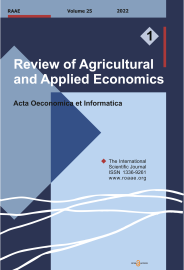KEYWORDS:
determinants; technical efficiency; small-holders; yam farmers
DOI NUMBER:
10.15414/raae.2021.24.01.13-20
ABSTRACT:
Research background: Yam is rated as a principal tuber crop in the Nigeria economy, contributing to more than 200 dietary calories per capita daily in West Africa. It’s also an important source of income generation and trade. However, increase in yam production over the years is attributed more to the large area planted than to increase in farm level productivity.Purpose of the article: This study aimed at estimating the determinants of technical efficiency and inefficiency levels in small-holder yam farms in Nigeria. The research specifically determined farm level technical efficiency and estimated farmers’ socioeconomic variables that contributed to inefficiency level in yam production in Nigeria.
Methods: Cross sectional data was collected from 80 yam farmers, randomly selected from the study area. Descriptive statistics (frequency, mean and percentage) and Cobb Douglas stochastic frontier production function model were the analytical tools used.
Findings & value added: Results indicated that the farmers were fairly educated and mainly males (75%) with a mean age of 36 years. Farmers level of education and their age showed negative influence on technical efficiency, while household size and farming experience showed positive influence on technical efficiency. MLE estimates indicated that coefficients of farm size and yam seedlings were significant at 5% while fertilizer and labour were not significant. Mean efficiency of yam farmers was 94.6%, indicating an allowance of 5.4% for improvement. The finding suggests that there is need to support yam farmers in the use of modern techniques in yam production, which would encourage older and educated farmers to remain in farming. High incidence of pest and diseases and high cost of farm labour were among other major challenges faced by the farmers. It is recommended that programmes that would help improve farmers’ access to input supplies at subsided rate should be put in place to enhance farm productivity.
Please Cite this Article as:
Mercy Ebere NDUBUEZE-OGARAKU, Olutola Ayodele ADEYOOLA, Cecilia Akuchinyere NWIGWE (2020) Determinants Of Technical Efficiency Of Small-holders Yam Farmers In Nigeria. Review of Agricultural and Applied Economics. XXIV (Number 1, 2020): 13-20. doi: 10.15414/raae.2021.24.01.13-20
URL for sharing:
https://roaae.org/1336-9261/doi/abs/10.15414/raae.2021.24.01.13-20
FULL TEXT PDF:
▼ direct download link| view online in fullscreen ▲
References:
▼ direct download link

